The first budgies with suffused green (a.k.a. dilute yellow), Grey-winged green, and lutino mutations were reported between 1870 and 1875. Since then, we have had 32 primary mutations and many varieties.
Many mutations have disappeared and reappeared throughout the budgerigar’s history. On the other hand, nowadays, with the help of science, we can reproduce specific budgies with specific mutations.
Today, budgies have 32 primary mutations such as opaline, pied, spangle, dilute, yellowface, albino, and lutino.
Mutations have their unique effects on the appearance of budgies. In addition to that, a budgie can have multiple mutations at the same time.
There are also specially named mutation combinations. For example, a rainbow budgie doesn’t have a single mutation. A rainbow budgie has opaline, clearwing (whitewing), and yellow or golden face mutations at the same time.
How can we categorize budgie mutations and varieties?
Scientists classify budgies specifically based on their mutations.
We can categorize budgie mutations in the following ways:
- Albinism, dilution, leucism, and melanism.
- Color mutations, striping pattern mutations, pies mutations, and other mutations.
- Structural, dilutistic, local-leucistic (pied), total-leucistic (clear), albinistic, cinnamon, SL-Albinism, melanism, dark wings, A-I-D dominant-clearBody, A-C-D opaline, S-L-R saddleBack, A-R Slate.
- Green series, blue series, yellow series, white series.
Although there are 3 types of categorization, we will explain budgerigar mutations with the second categorization in the list above.
What does the base color mean in budgies?
Budgies have two base colors, which are white and yellow. The yellow color is dominant, while the white color is recessive.
Color mutations
Color mutation’s category includes mutations such as dark factor, gray factor, violet factor, dilution, yellowface, goldenface, albino, and lutino.
The mutations also have their sub mutation variations. For example, one dark factor and two dark factors for dark factor mutation.
Dark factor mutation
The dark factor gene is a semi-dominant to normal gene. As a result, the semi-dominant trait generates three visual variations such as normal (two normal genes), one factor (one dark factor gene and one normal gene), and two factors (two dark factor genes).
The dark factor mutation generates many sub-varieties of both yellow series and white series budgies.
Dark factor mutation generates light green, dark green, and olive green varieties of green series, while sky-blue, cobalt, and mauve of blue series.
Light green budgie
A light green budgie is a green series budgie without any dark factor gene.
Light green budgies are also the most common type of budgie population worldwide. Especially, all wild budgies are mostly light green.
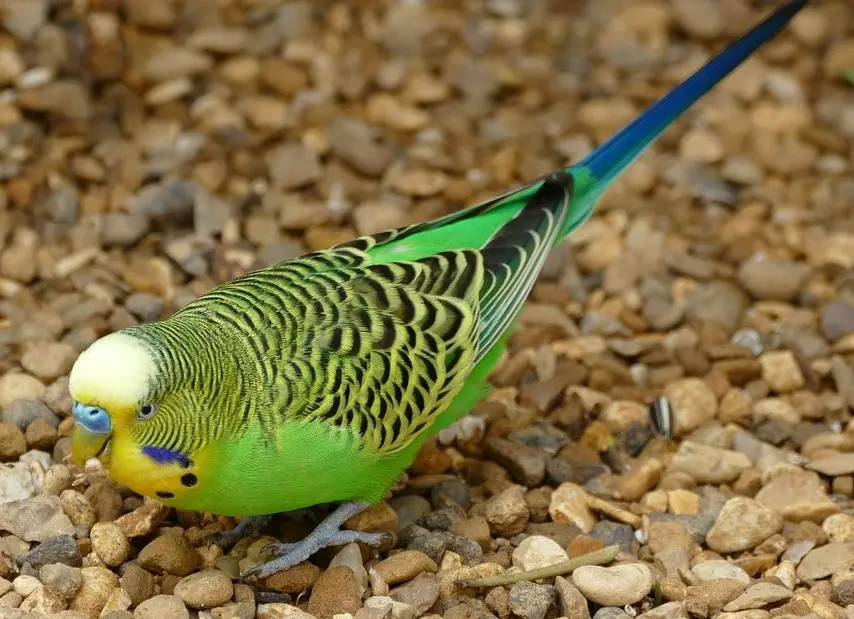
Dark green budgie
A dark green budgie is a green series budgie with one dark factor gene and one normal gene.
As a result, a darker green budgie than a light green budgie appears. The dark factor gene can show a slight darkening effect on the budgie.
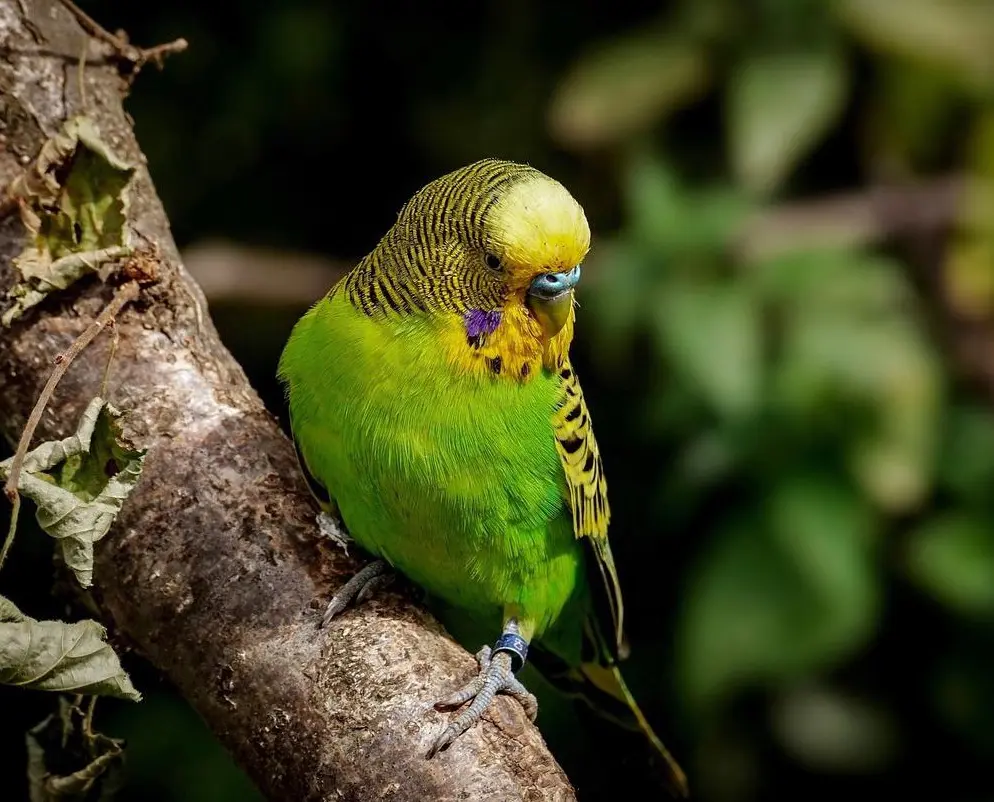
Olive green budgie
An olive green budgie is a green series budgie with two dark factor genes.
Olive green budgies are the darkest variety of dark factor green budgies. Of course, they take their name from the olive, as they have a color close to olive green.
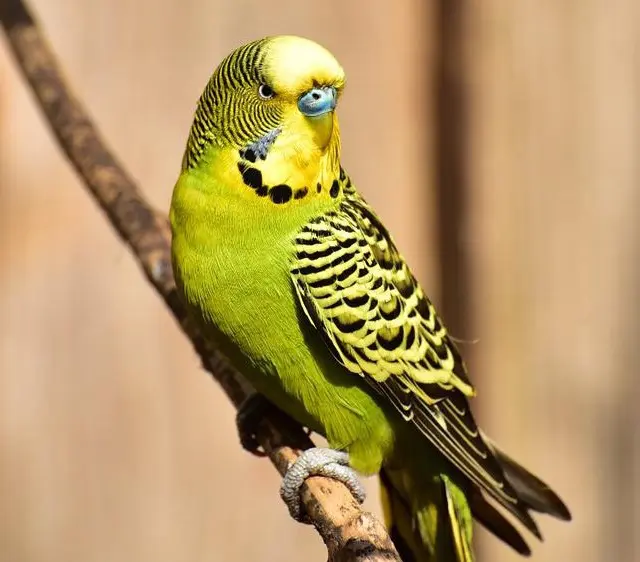
Sky-blue budgie
A sky-blue budgie is a blue series budgie without any dark factor gene.
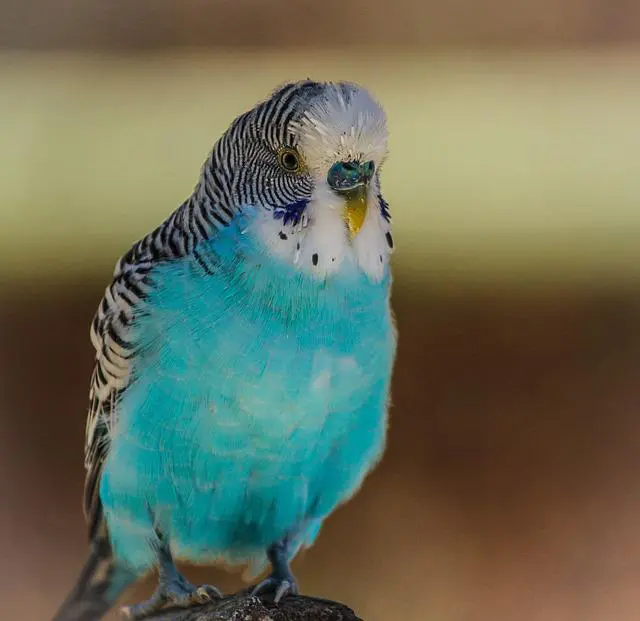
Cobalt budgie
A cobalt budgie is a blue series budgie with one dark factor gene and one normal gene.
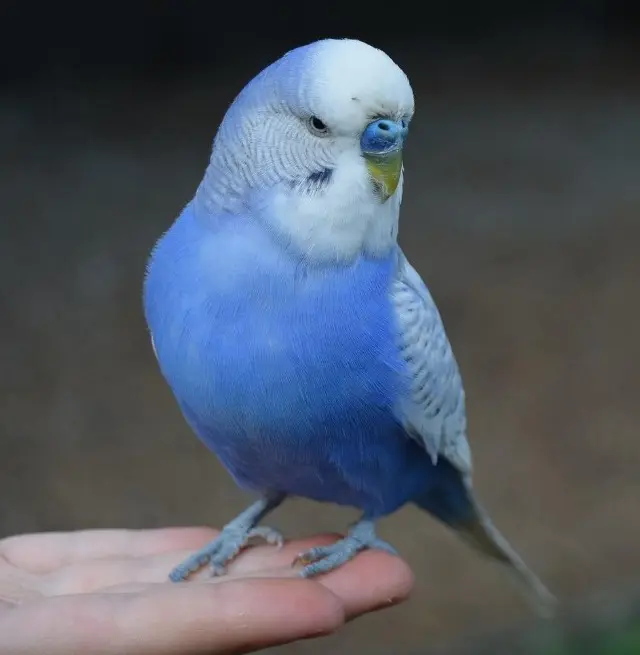
Mauve budgie
A mauve budgie is a blue series budgie with two dark factor genes.
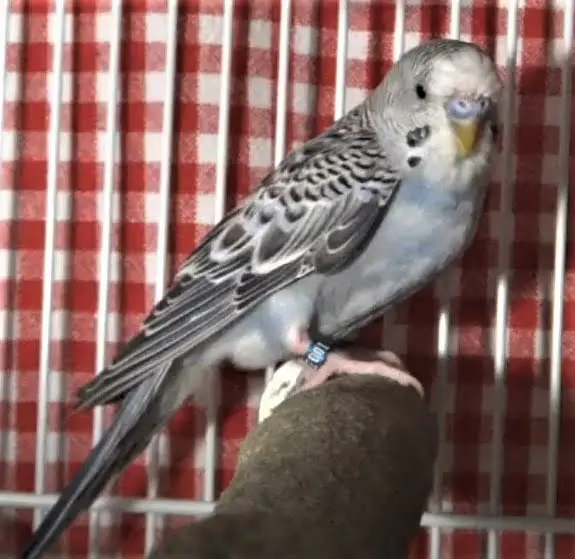
Gray factor mutation
The gray factor mutation is a dominant mutation. Besides, the gray factor mutation adds an extra gray color layer and overrides the budgie’s original body color.
The gray factor mutation modifies both the green series and the blue series. As a result, the gray factor mutation generates green-gray color variety in the green series, while the gray color variety in the blue series.
Gray-green (Gray factor)
A gray-green budgie is a green series budgie with a gray factor gene. Besides, the gray-green is similar to olive-green budgies, which have two dark factor genes. But, the gray-green variation is slightly brighter than olive green budgies.
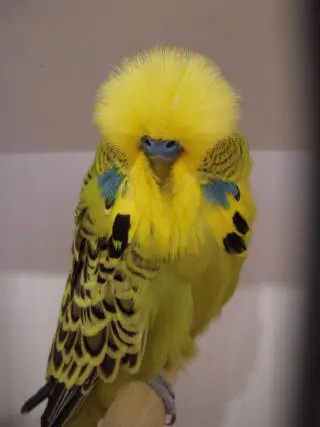
Gray (Gray factor)
A gray budgie is a blue series budgie with a gray factor gene.
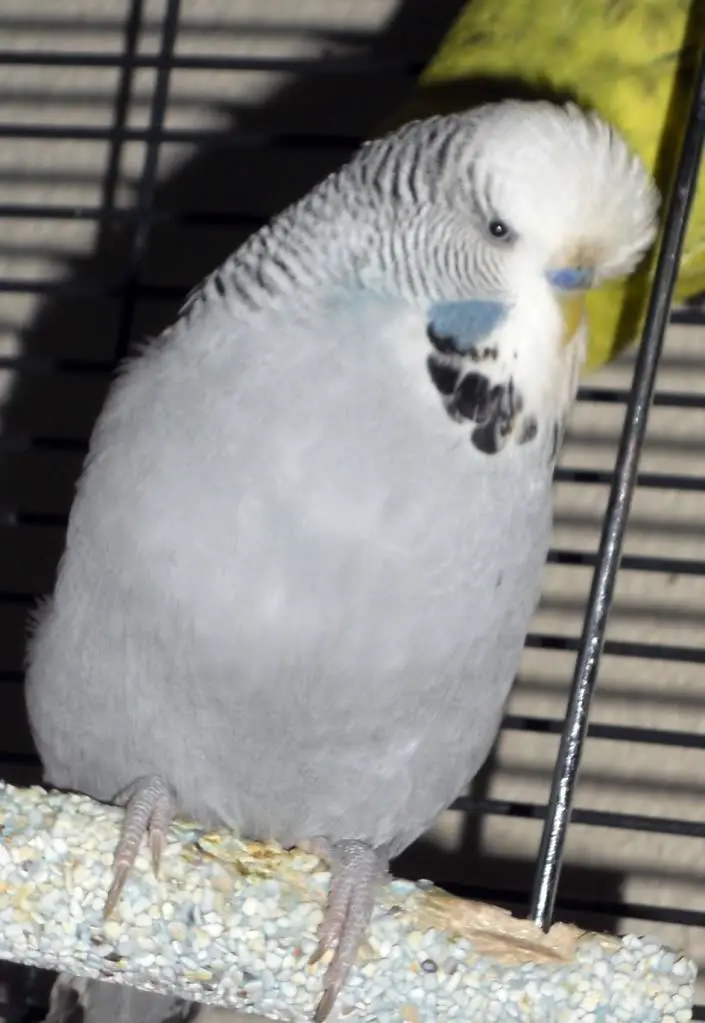
Violet factor mutation
The violet factor gene is a semi-dominant to normal gene. The semi-dominant trait allows for variations that look different from one another. For example, two normal genes, one normal and one violet factor gene, and two violet factor genes have different color appearances.
Single-factor (SF) violet mutation
A single factor violet budgie is a violet budgie with one violet factor gene and one normal gene.
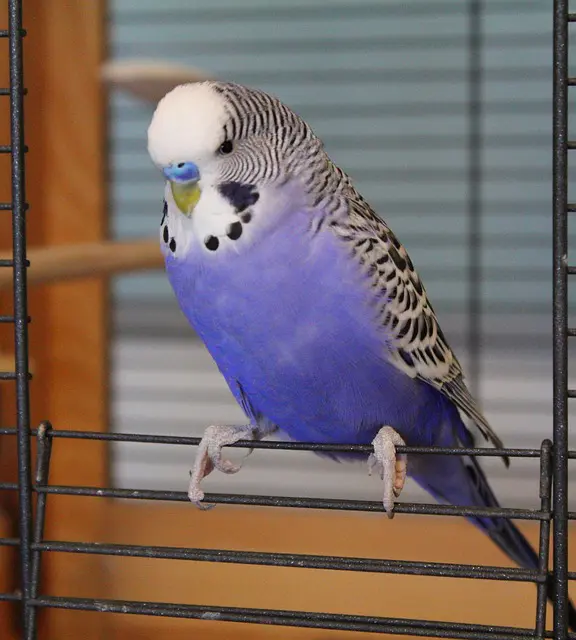
Double-factor (DF) violet mutation
A double factor violet budgie is a violet budgie with two violet factor genes.
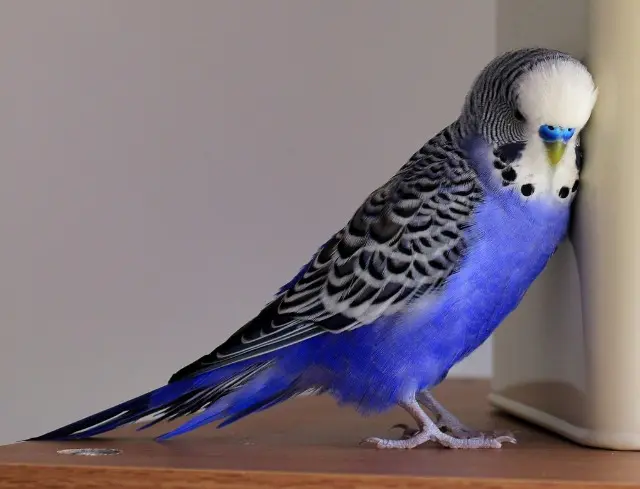
Dilution mutation
The dilution mutation has four alleles such as normal, greywing, clearwing, and dilute. As a result, these alleles produce four variants: greywing, full-body-color greywing, clearwing, and dilute.
Normal gene is dominant, both clearwing and clearwing are recessive and co-dominant with each other, and dilute is recessive.
Greywing
The Greywing mutation changes the wings and body differently. The mutation produces more pigment in the wing feathers and less pigmentation in the body feathers. As a result, the budgerigar has gray markings on its wings and a 50% dilution of body feathers.
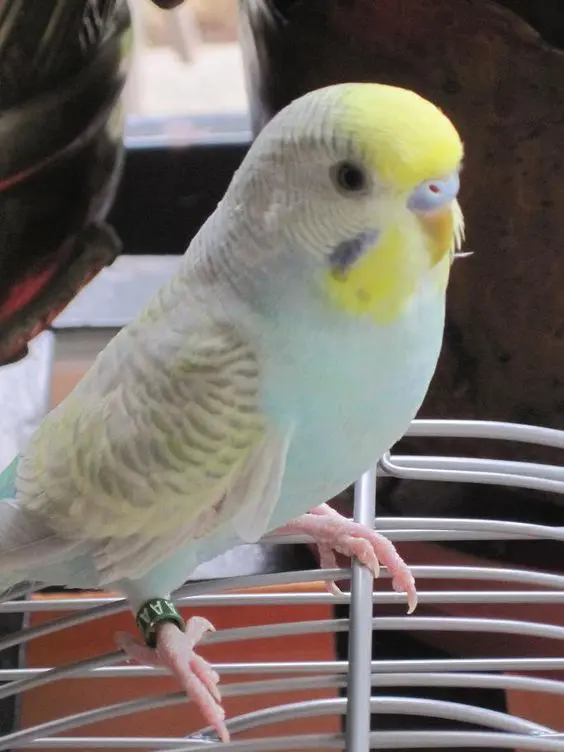
Clearwing
The Clearwing mutation changes the wings and body differently. The mutation produces more pigment in the body feathers and less pigmentation in the wing feathers. As a result, the budgerigar has light markings on its wings and bright body feathers.
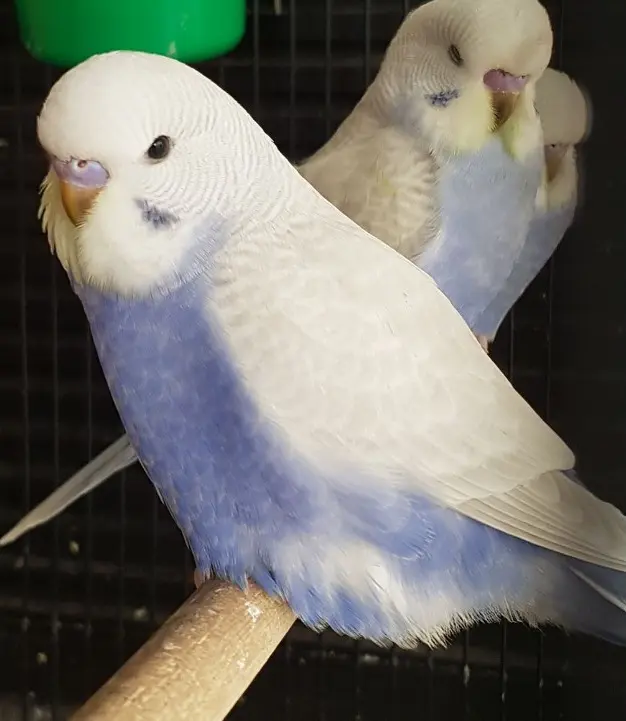
Full-body greywing
Full-body greywing mutation refers to when a budgie has both greywing and clearwing genes simultaneously. Besides, full-body greywings have 10% diluted body color.
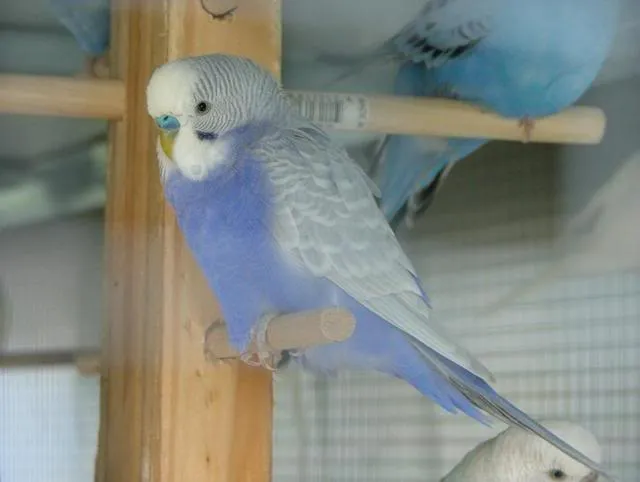
Dilute
The dilute gene is a recessive gene mutation. To explain, a dilute budgie needs two dilute genes, that come from both parents, to be a dilute budgie. Besides, the mutation is a diluting mutation. As a result, the dilute mutation dilutes 70% of the body colors and markings.
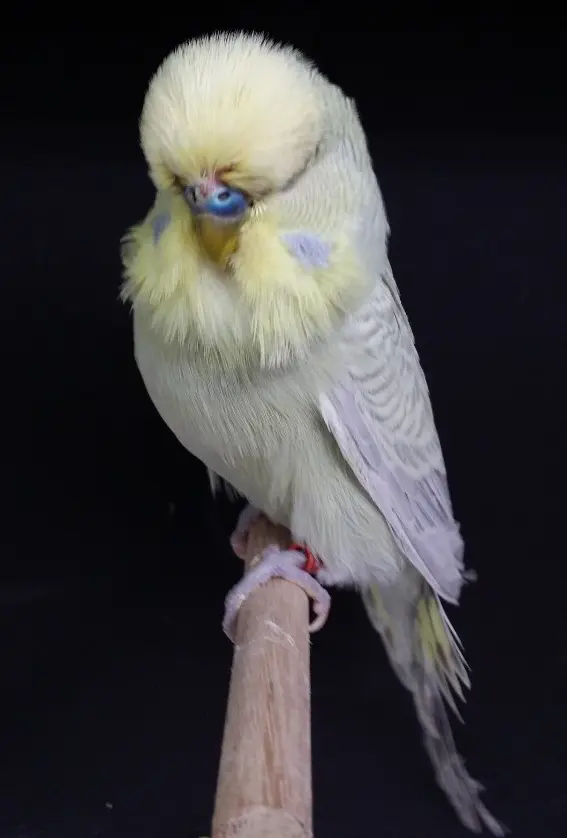
Yellowface & Goldenface mutations
There are three types of mutations in this group of mutations: yellowface type 1 (single factor), yellowface type 2 (single factor), and goldenface (single factor.) Besides, all three mutations have double factor mutation versions. As a result, budgies can have 6 different mutation variations.
Yellowface and golden face mutations are hard-to-understand mutations. Besides, all three mutations are yellow-reducing mutations. The mutations give the yellow appearances by reducing the yellow pigmentations.
Also, single factor and double factor traits determine the level of reduction. For example, a double factor yellowface type 1 budgie looks like a white face budgie, while a single factor yellowface budgie looks like a lemon-colored yellow face.
Double factor yellowface and golden face mutations reduce more yellow pigmentation than the single factor mutations from the same areas.
Single factor yellowface type 1 mutation
Yellowface type 1 mutation (single factor) gives budgies a lemon or buttercup yellow mask on the face and tails. Besides, the mutation doesn’t affect the body colors.
![All budgie mutations & varieties [+PHOTOS]](https://www.petiska.com/wp-content/uploads/2022/05/all-budgie-mutations-varieties-photos-1652694029.jpg)
Double factor yellowface type 1 mutation
Yellowface type 1 mutation (double factor) reduces pigmentation on the face more than the yellowface type 1 single factor, and the budgie becomes almost a white-faced budgie.
Single factor yellowface type 2 mutation
Yellowface type 2 mutation gives budgies a lemon or buttercup yellow mask on the face and tails. Besides, the mutation affects the face and also chest areas.
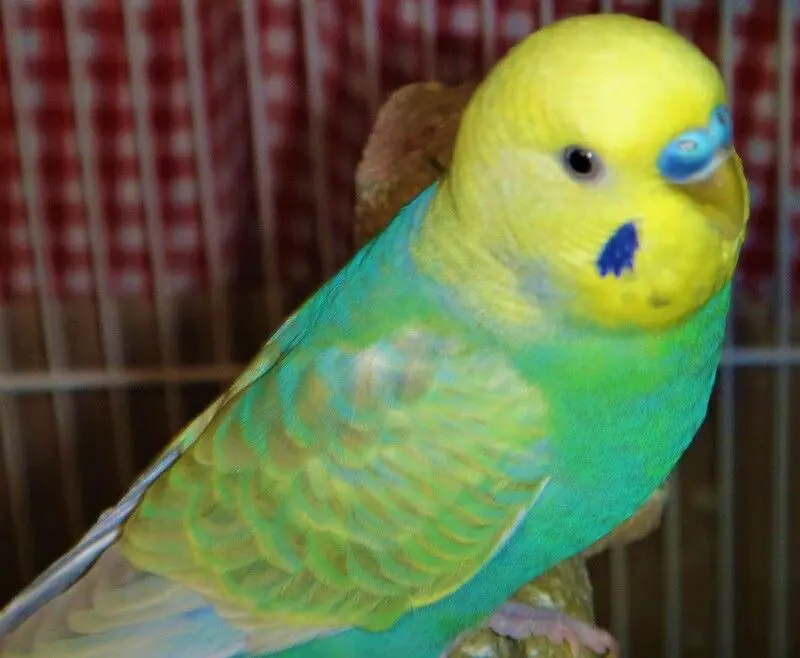
Double factor yellowface type 2 mutation
Yellowface type 2 mutation (double factor) gives budgies a lemon or buttercup yellow mask on the face and tails. Besides, the mutation reduces yellow pigmentation in the face and chest areas more than the single factor yellowface type 2 mutation.
Single factor goldenface mutation
Goldenface mutation gives budgies a lemon or buttercup color face, body, and tail.
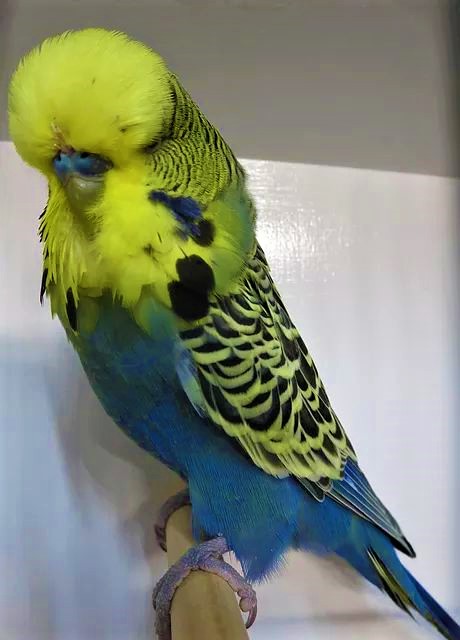
Double factor goldenface mutation
Double factor goldenface mutation gives budgies a lemon or buttercup color face, body, and tail. The mutation also reduces the yellow pigmentation more than the single factor goldenface mutation from the same area.
Albino mutation
The albino mutation occurs by a gene called ino, which inhibits melanin production in blue series budgies. Besides, the ino gene is a sex-linked recessive gene.
Basically, the ino gene creates an albino budgie by removing the body colors and markings in blue series budgies.
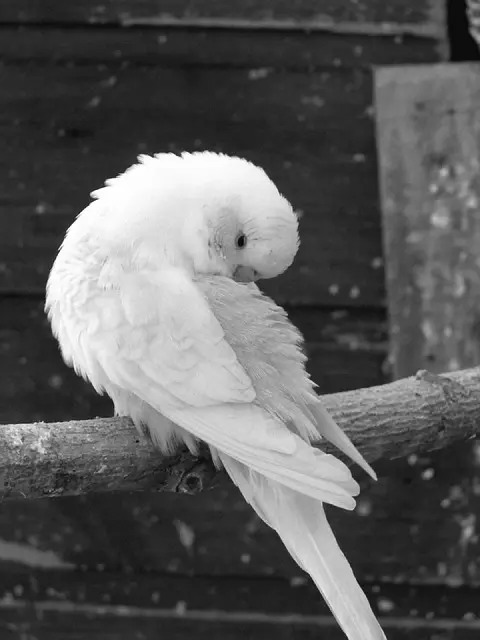
Lutino mutation
The lutino mutation occurs by a gene called ino, which inhibits melanin production in green series budgies. Besides, the ino gene is a sex-linked recessive gene.
Basically, the ino gene creates a lutino budgie by removing the body colors and markings in green series budgies.
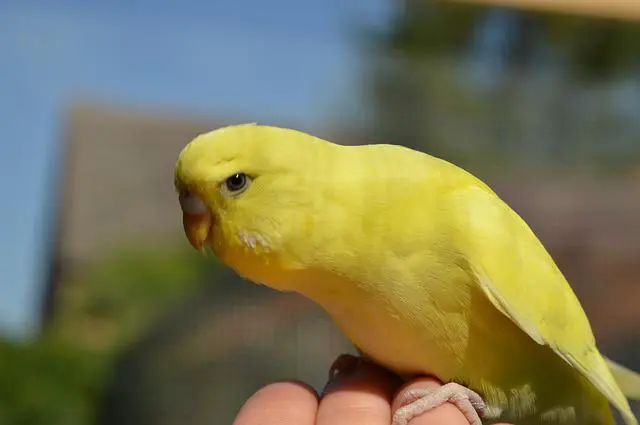
Striping pattern mutations
Simply put, the stripping pattern mutations manipulate the colors and patterns of the markings on the budgie body.
Opaline mutation
The opaline mutation is a sex-linked and recessive mutation transferred with the “X” gene.
The opaline mutation reverses the striping patterns in the top of the head and back of the budgie’s body. As a result, budgie gets more body-colored feathers and fewer black markings.
The mutation also transforms the body color from 10% to 20% lighter.
The opaline mutation often gives budgies an opalescence effect on their back wings, which gives the mutation its name, called “Opaline.”
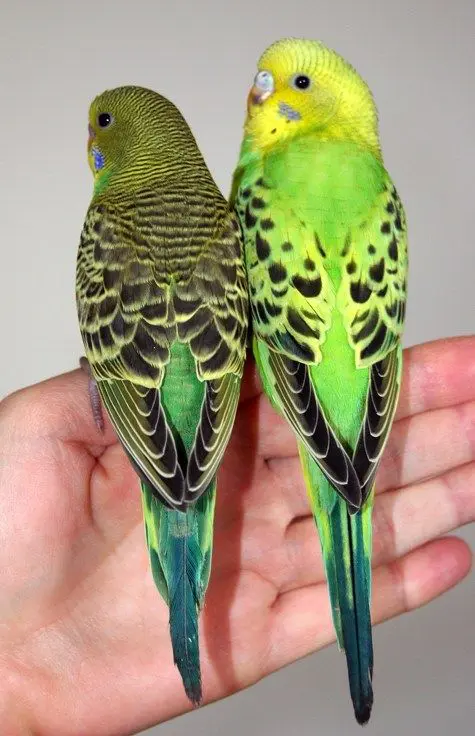
Spangle mutation
The spangle mutation has two alleles, which are the spangle gene and the normal gene. Besides, the spangle gene is a dominant gene and semi-dominant to the recessive normal gene. As a result, a budgie can be one of three potential appearances: normal, single factor spangle, or double factor spangle.
A single factor spangle budgie has one normal gene, and one spangle gene, while a double factor spangle budgie has two spangle genes. Both variations have different visual appearances.
Single factor spangle mutation
Single factor spangle mutation makes a budgie feather’s center white or yellow and creates a black line on the edges of the feathers.
Besides, the throat spots, tail feathers, and markings of a single factor spangle budgie are often missing or partially missing.
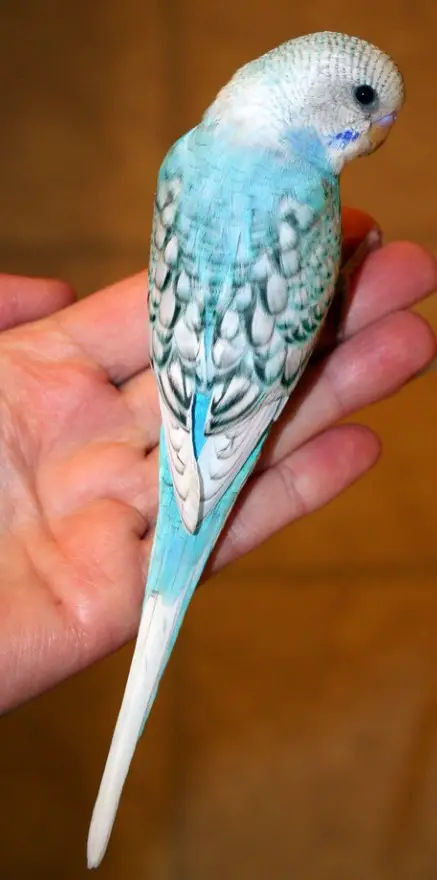
Double factor spangle mutation
Double factor spangle mutations remove all markings from the feathers. As a result, the budgie becomes fully white or yellow, depending on its base color.
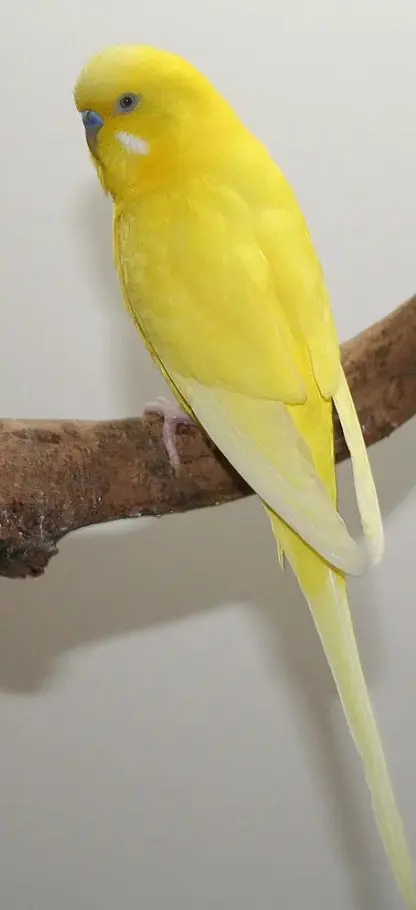
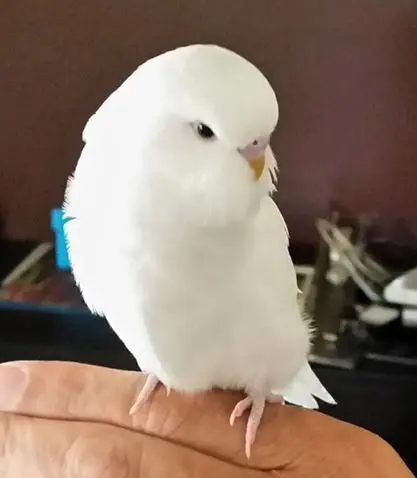
Cinnamon mutation
The cinnamon gene is a recessive gene. Besides, it is a sex-linked gene, which means it is located and transferred on the x-chromosome.
List of changes made by the cinnamon mutation in budgies:
- The mutation changes the color of head strips, wing markings, and body markings from black to brown.
- Markings of the male cinnamon budgies are darker than female cinnamon budgies.
- The color of the long tail feathers is lighter than normal budgies.
- The color of the body color and the cheek patches is approximately 50% paler than normal budgies.
- The body feathers of the cinnamon budgies are tighter than normal budgies. As a result of that, the cinnamon budgies have a silky appearance.
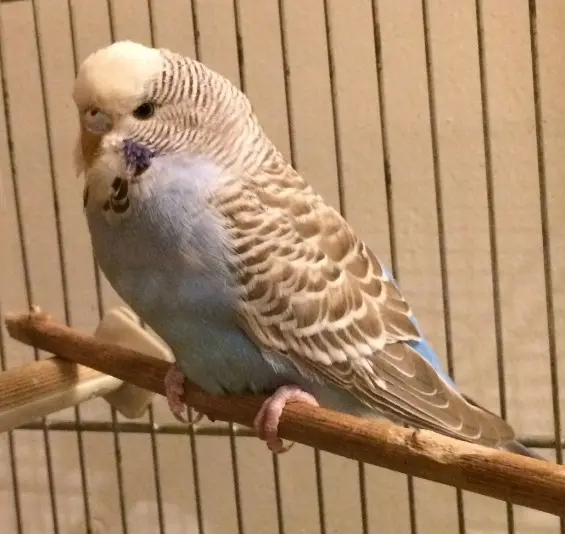
Pied mutations
Simply put, the family of pied mutations produces pied-looking budgies.
Recessive pied mutation
The recessive pied mutation is a recessive gene mutation. The base color of the budgies (white or yellow) covers most parts of the body.
Typically, the recessive pies budgies split their body color in half. The top part is the base color and the bottom half is the body color. For example, the top part is white, while the bottom part is blue in the blue series; the top part is yellow, while the bottom part is green in the green series.
The recessive pied mutation removes the iris ring from the eyes. This trait makes the budgie a baby-looking budgie throughout all its life, even if it is an adult budgie.
Also, the recessive pied mutation gives a pink cere and fleshy pink feet in both male and female budgies.
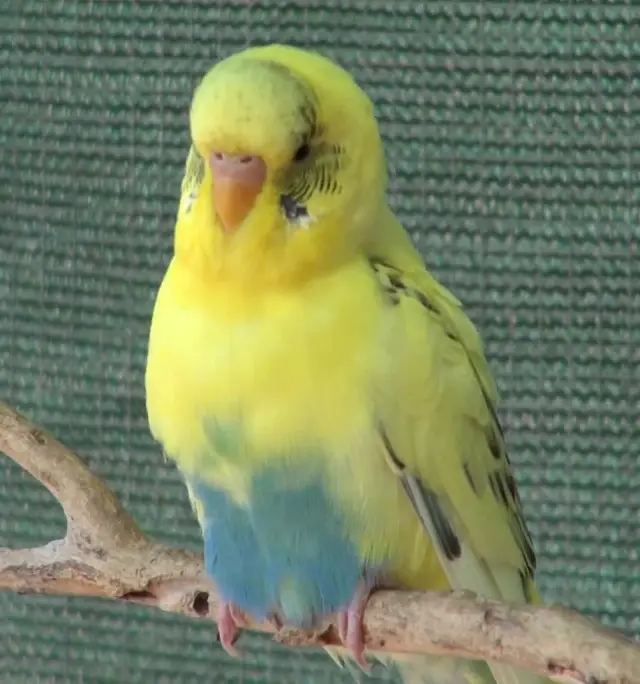
Dominant pied mutation
The dominant pied mutation is a dominant gene mutation and has two variations: single factor and double factor.
The single factor dominant pied mutation
Dominant pied mutation gives base-colored tail feathers.
The single factor dominant pied mutation refers to a budgie that has one dominant pied gene that comes from only one parent.
The single factor dominant pied budgies have a base-colored (white or yellow) horizontal ring/band at the center of the body.
The SF dominant pied mutation reduces the body color (white or yellow) by about 50%.
In addition, the SF dominant pied budgies have a base-colored (yellow or white) pied patch back of their head.
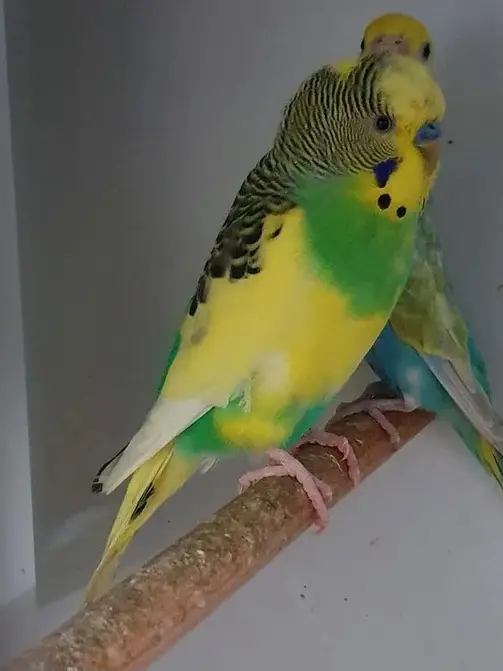
The double factor dominant pied mutation
The double factor dominant pied mutation refers to a budgie that has two dominant pied genes that come from both parents.
The DF dominant pied mutation removes body markings and body colors. Besides, it expands the pied area at the back of the head of the budgies.
As a result, the DF dominant pied budgies show almost only the base colors (white or yellow) all over the body. Some budgies may still show a weak colorization. The marking and colors are only visible on the neck, rump, and between the top wings.
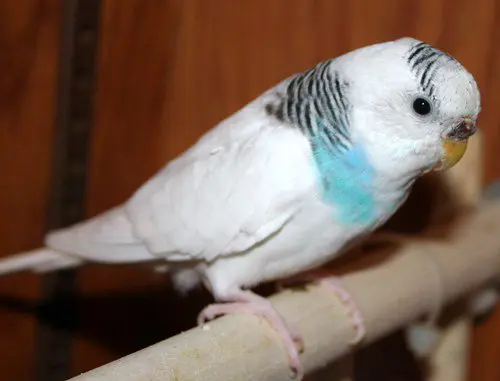
Australian pied mutation
Australian pied budgies have base-colored (white or yellow) irregular patches that may appear anywhere on the body, head, or wings.
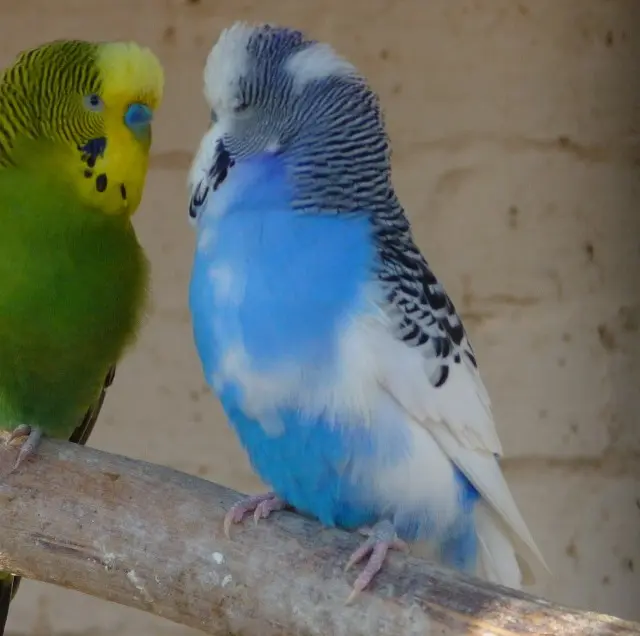
Clearflight pied mutation
The clearflight pied mutation is a dominant mutation.
The clearflight pied mutation transforms the color of the flight feathers to the base colors (white or yellow.) This characteristic gives the mutation its name.
The clearflight pied mutation also gives the budgie a clear patch on the back of its head. The patch is yellow in green series budgies, while white in blue series budgies.
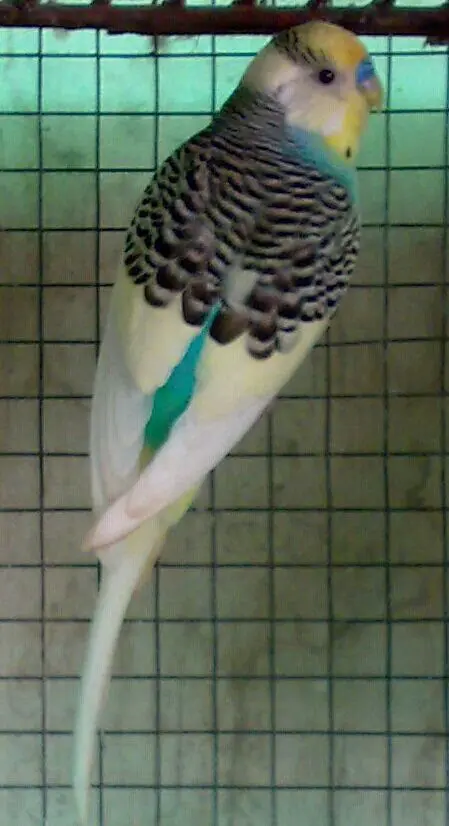
Dark eyed clear variety
The dark eye clear variety is a combination of two mutations: the recessive pied and clearflight pied mutations.
All body colors of the dark eyed clear (DEC) budgies are base-colored (yellow or white.) Besides, they have no shades of markings on the body. They look like albino and lutino budgies, depending on the base body colors.
Also, the dark eyed clear (DEC) budgies have solid black colored eyes with no iris ring.
The DEC budgies have pink feet and silvery cheek patches.
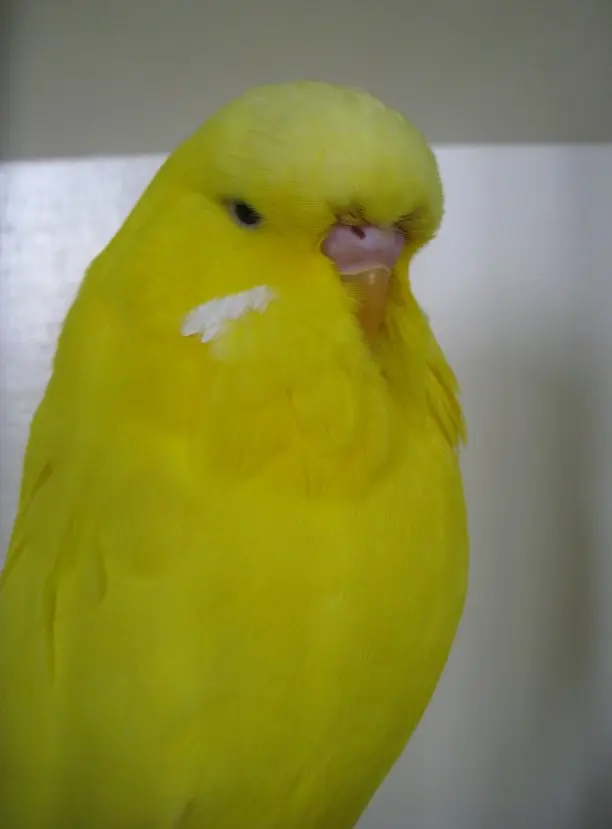
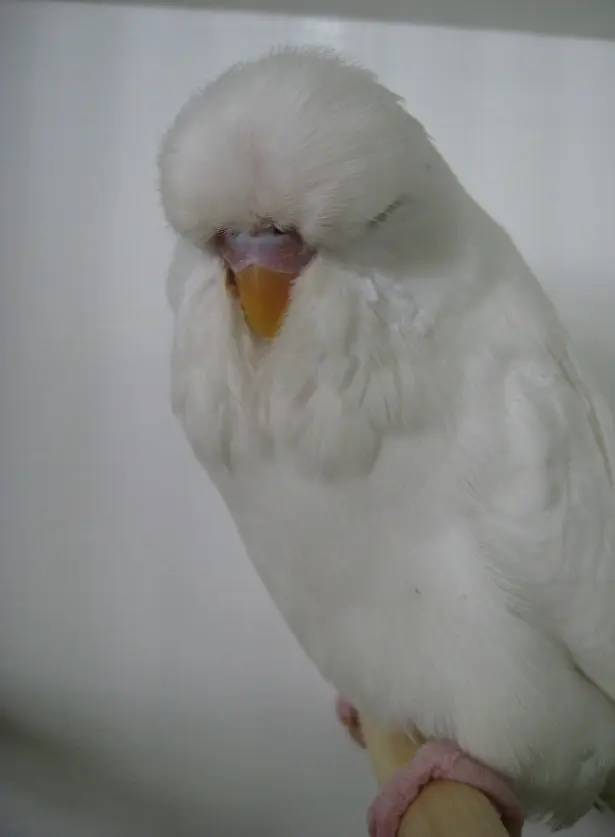
Rare & other mutations
As time progresses, new mutations and varieties appear in budgies.
Crest mutation (Crested budgies)
The crest mutation is one of the easy-to-recognize mutations of all budgie mutations. The crested budgies have crest-like head feathers, which have multiple variations.
“The Initiator Theory” and “PE theory” are currently accepted crested budgie breeding theories.
The crest mutation family has three mutation variations: full circular, half-circular, and tufted.
Full circular (round) crested (Full crested) budgie
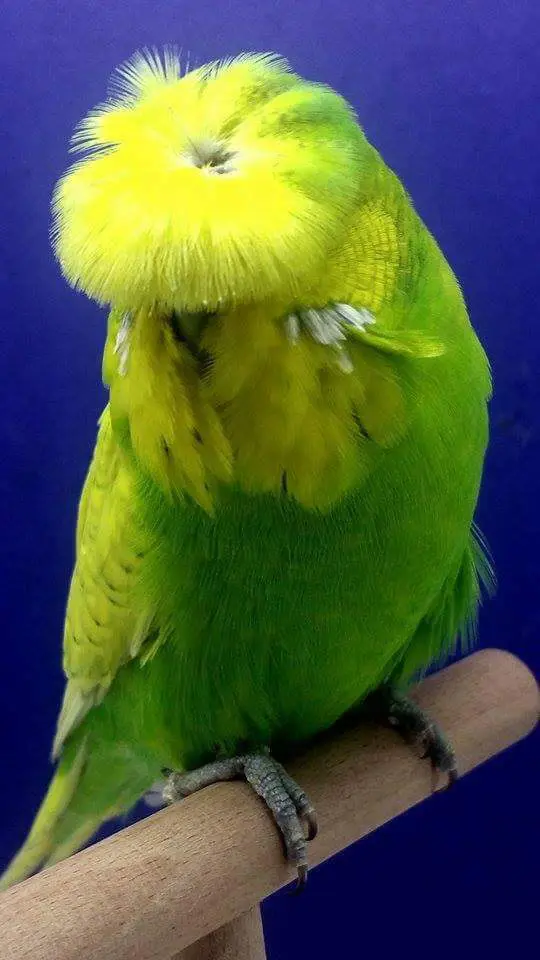
Half circular (round) crested (Half crested) budgie
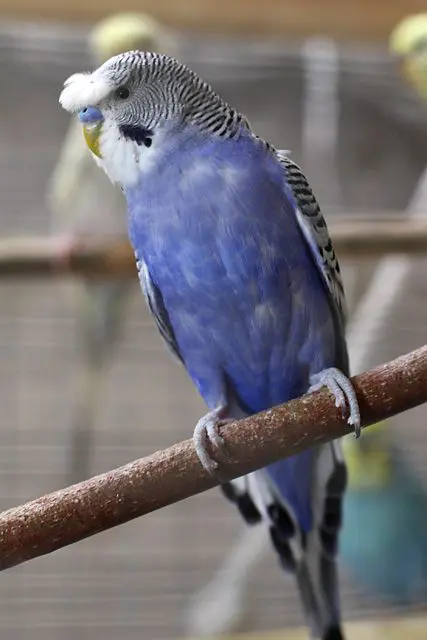
Tufted crested budgie
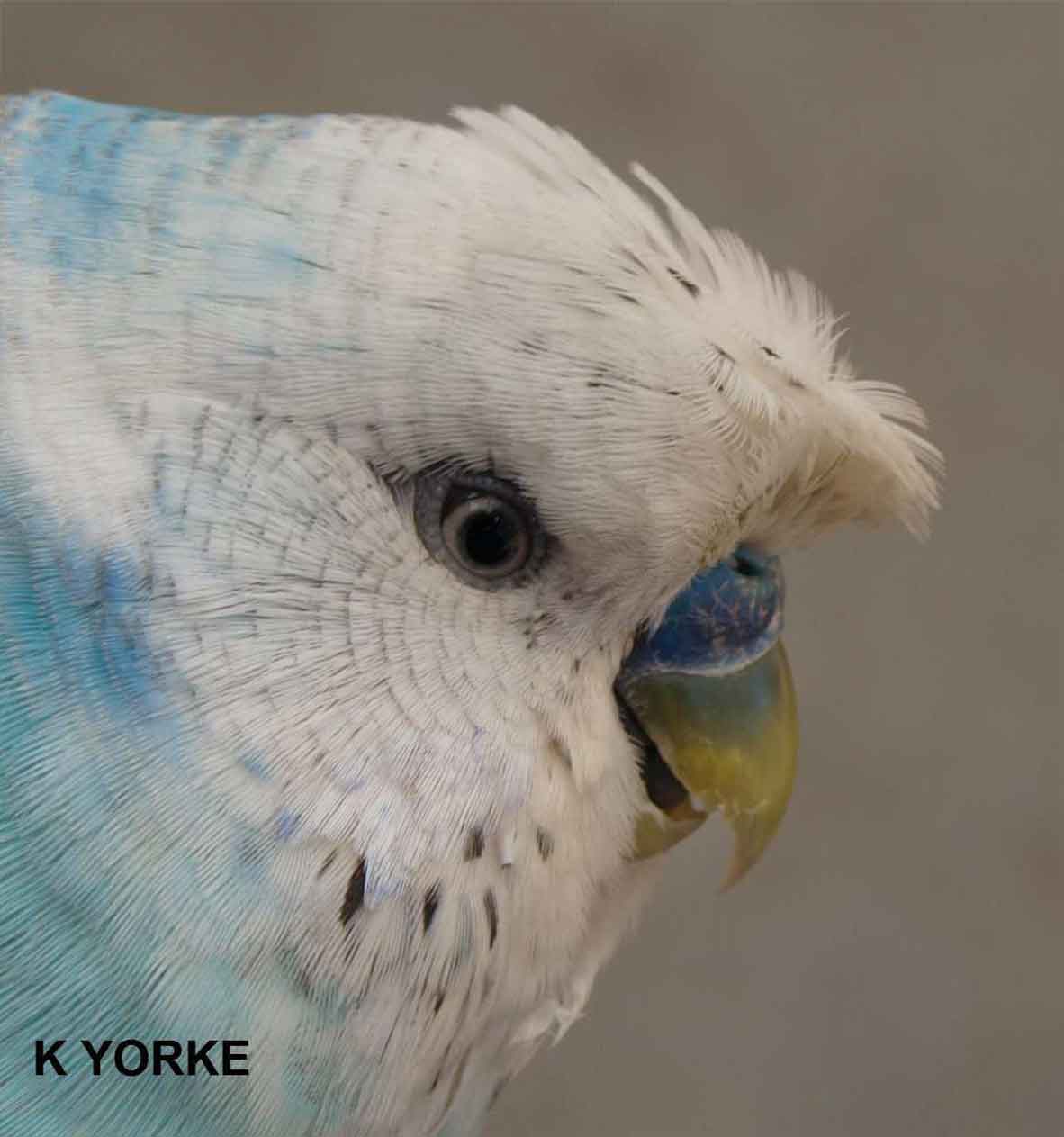
Japanese helicopter (hagoromo) mutation
Japanese helicopter (hagoromo) budgies appeared in the 1960s in Japan. They have a unique appearance that makes them easy to recognize.
Japanese helicopter (hagoromo) budgies have 18 feathers on their back that look like petals in different directions. They also have back frills between the flowers, and crests on their heads.
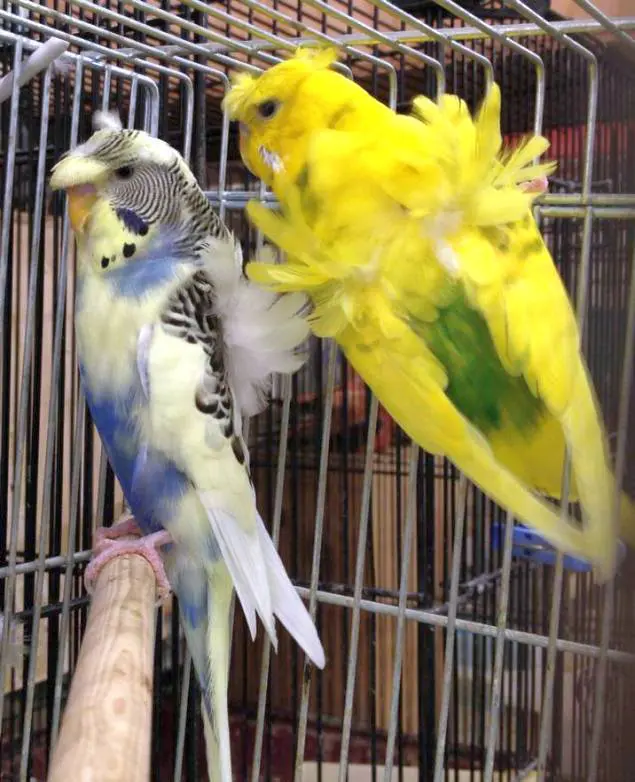
Fallow mutation
The fallow mutation is a recessive to normal mutation. The mutation weakens the body colors by reducing the pigmentation all over the body.
For example, the fallow mutation transforms the throat spots, head and neck striations, and wing markings from black to medium brown color.
The fallow mutation also transforms the color of eyes, feet, and skin color. For example, a fallow budgie has red or ruby-red color eyes.
The fallow mutation has many varieties such as English, German, Scottish, Australian, Japanese, bronze, pale, dun, smokey and ashen, light green, dark green, olive green, gray-green, sky blue (light blue), cobalt (dark blue), mauve, violet, gray-blue.
However, English, German, and Scottish varieties are the most known varieties of fallow budgies.
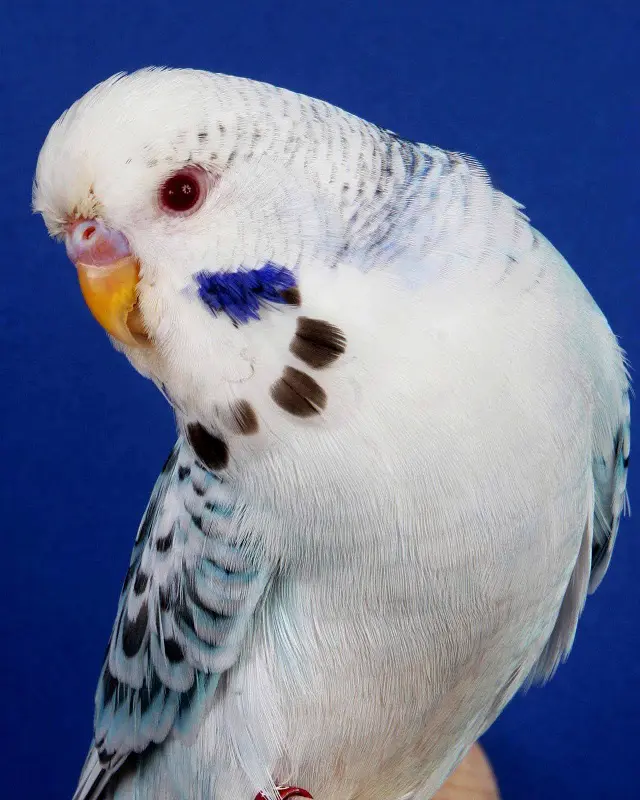
Saddleback mutation
Saddleback mutation is a recessive mutation.
Saddleback mutation gives the budgie’s back a clearly defined “V” shaped area (saddle area). Besides, the markings on the head and neck area are thin and gray.
![All budgie mutations & varieties [+PHOTOS]](https://www.petiska.com/wp-content/uploads/2022/05/all-budgie-mutations-varieties-photos-1652791918.jpg)
Texas clearbody mutation
The Texas clearbody mutation is recessive to the normal gene and dominant to the ino gene. Besides, the Texas clearbody mutation is a sex-linked mutation.
The Texas clearbody (TCB) budgies have a minimum of 50% pale blue or pale green body colors or absent body colors. If the body has a color, it gets darker towards the bottom and rump areas.
Besides, the wing markings are black at the top of the wings and fade to light gray towards the edges.
Besides, the cheek spots are violet and the throat spots are pale black.
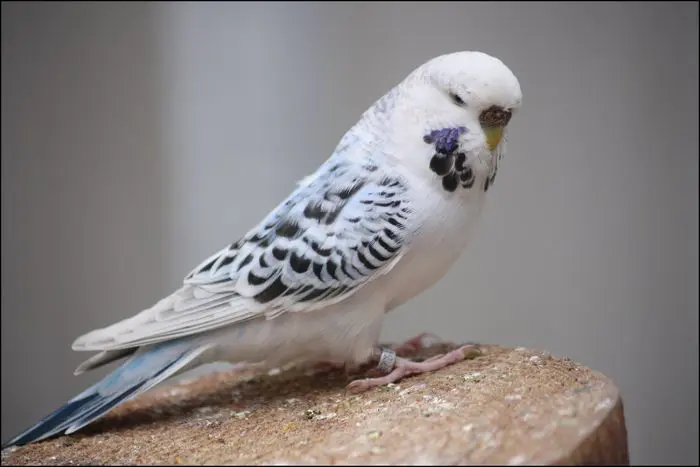
Slate mutation
The slate mutation is recessive to the normal gene. Besides, the mutation is sex-linked and is transferred on the X-chromosome. This mutation is extremely rare.
Simply put, the slate mutation is a color-adding mutation. The mutation produces bluish-gray body color in blue series budgies. Besides, the mutation shows itself better on sky-blue budgies.
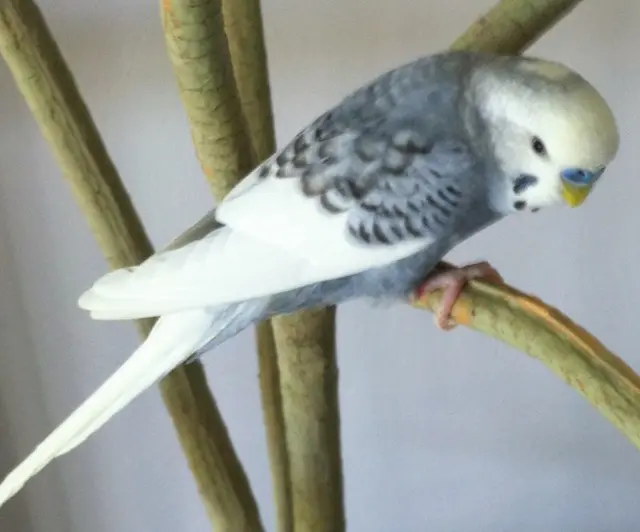
Anthracite mutation
Anthracite gene is semi-dominant to normal gene. This mutation is a rare mutation.
A budgie can be a single factor or double factor anthracite budgie due to the semi-dominant trait of the anthracite gene.
An anthracite budgie has a black or deep gray colored body. Besides, the cheek patches are the same colored as the body.
The single factor anthracite mutation produces a darkening effect on budgies, like the dark factor mutation.
The double factor anthracite mutation darkens the body color even more than the single factor. As a result, the budgie gets the anthracite-colored body color. This variety also gives the mutation its name.
![All budgie mutations & varieties [RARE,+PHOTOS]](https://www.petiska.com/wp-content/uploads/2022/05/all-budgie-mutations-varieties-rarephotos-1652798975.jpg)
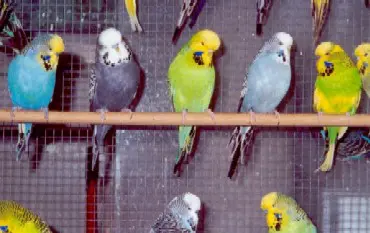
Blackface mutation
The blackface gene mutation is a dominant gene mutation to the normal gene. The gene also is a melanistic mutation. Besides, this mutation is extremely rare.
The blackface budgie has black stripes that run from the top of the head to the face, mask, and body. In addition, the mutation causes a darkening effect on body color.
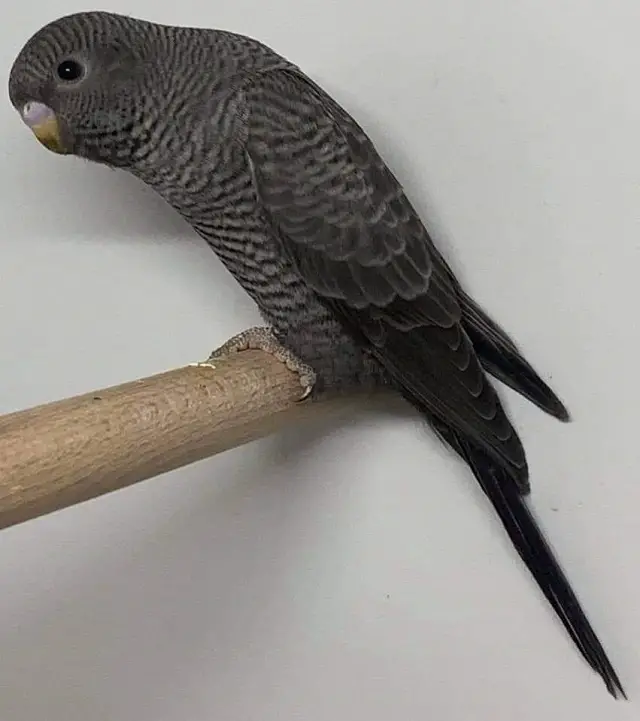
Mottled mutation/variety
Budgie breeders and fanciers do have not enough information to clearly describe the mottled budgie genetics.
The mottled budgies are born like any other budgies. But, after every molting season, the budgie’s feathers get pied areas. At first glance, in the first few molting, the budgie looks like a recessive pied budgie that has white iris rings. Eventually, after a sufficient number of molts, all feathers are completely free from markings and colors.
The mottled is not conclusively proven to be a disorder or a new mutation. But, a similar pigmentation disorder is known in other species such as dogs, guinea pigs, cats, and mice.
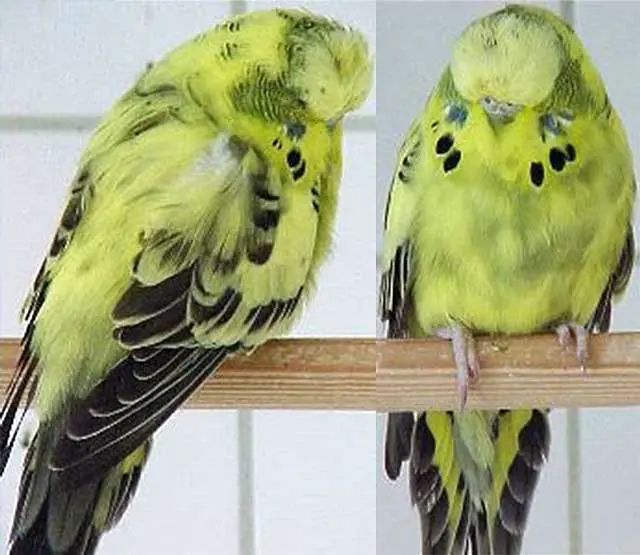
Half-sider variety
Half-sider variety is not a mutation, but a genetic condition. Therefore, the half-sider trait is not genetically inherited.
The “Half-sider” characteristic occurs by tetragametic chimerism which is a rare condition.
Simply put, tetragametic chimerism is a form of congenital chimerism. Two different sperm cells fertilize two different egg cells. Finally, all of these cells fuse to form a single budgie embryo. If two fertilized eggs are different in colors, then a half-sider budgie forms.
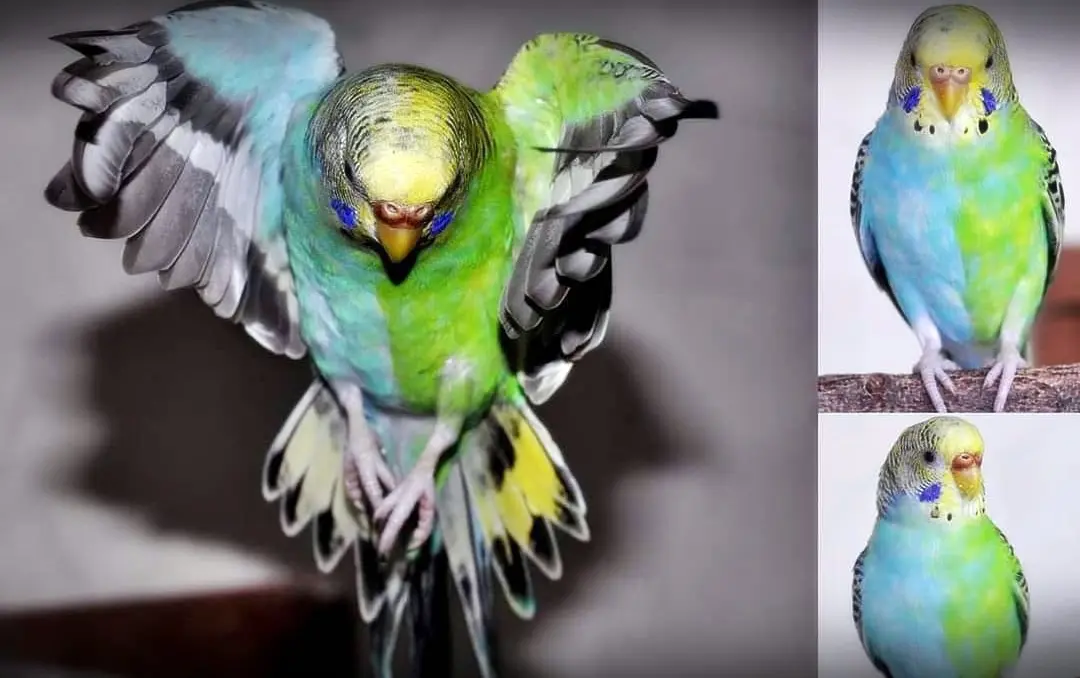
Mutation combinations
Budgie breeders, fanciers, and pet shops generate mutation combinations for commercial, aesthetic, or competition reasons.
The budgie breeders combine multiple mutations to get a particular budgie. For example, a pet shop designed the first rainbow budgies for commercial reasons. A rainbow budgie has opaline, clearwing (whitewing), and yellow or golden face mutations all together.
Rainbow mutations combination
Rainbow budgies are a mutation combination that includes opaline, clearwing (whitewing), and yellow or golden face mutations.
The rainbow budgies first appeared on a bird farm, in England. The combination is designed for commercial considerations.
The colorful appearance of rainbow budgies has made them popular day by day.
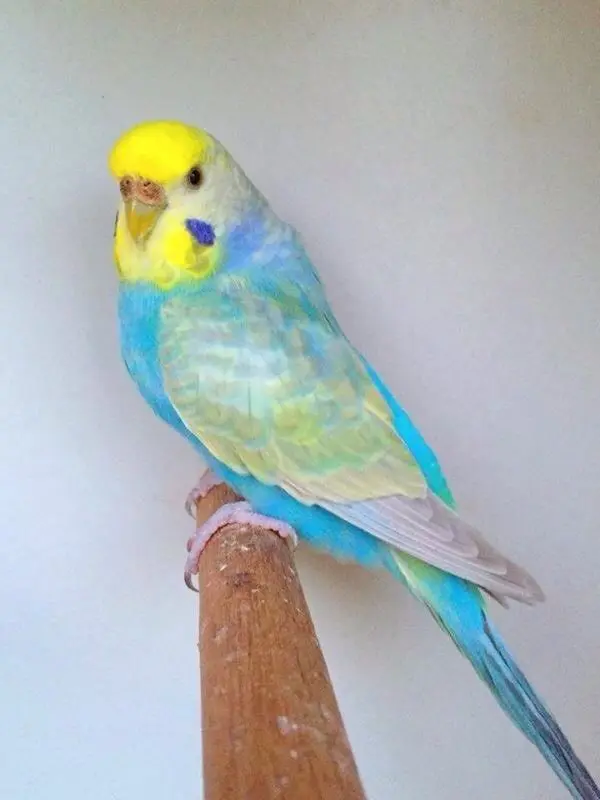
Lacewing mutations combination
A budgie must have both the cinnamon and the ino mutations at the same time to be a lacewing budgie.
The lacewing budgies are popular among the exhibition budgie breeders.
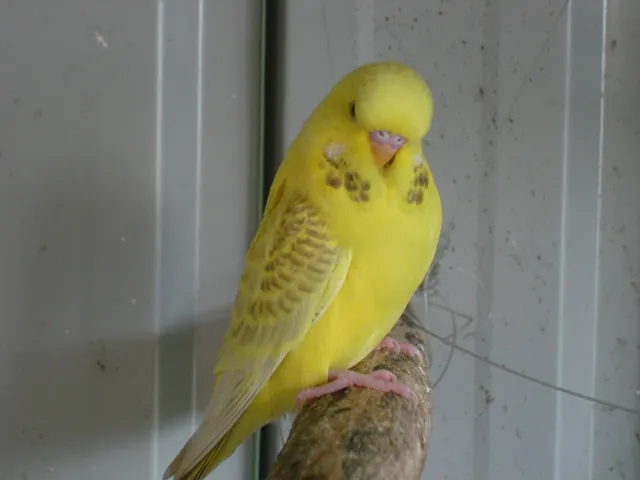
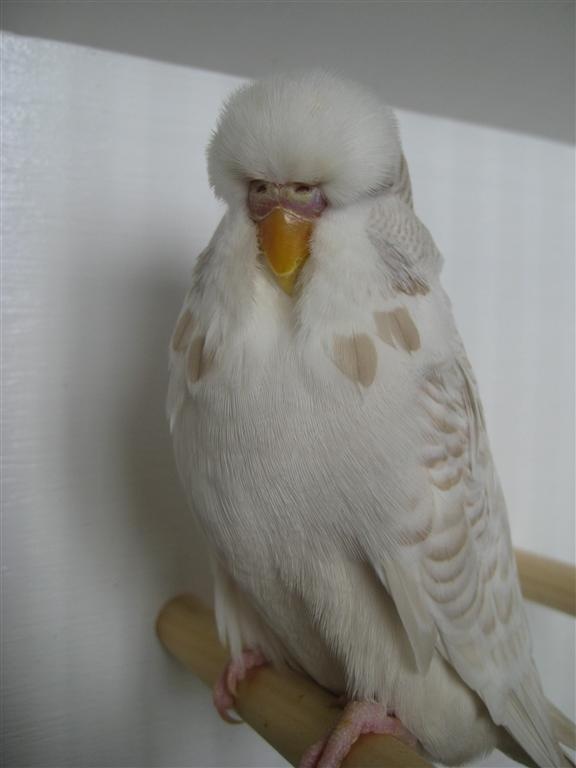
Creamino budgies
Cremino budgie is an albino budgie with goldenface or yellowface mutations.
The goldenface or yellowface mutation adds a yellow layer to the albino, which is a blue series budgie. Finally, we get creamino budgies.
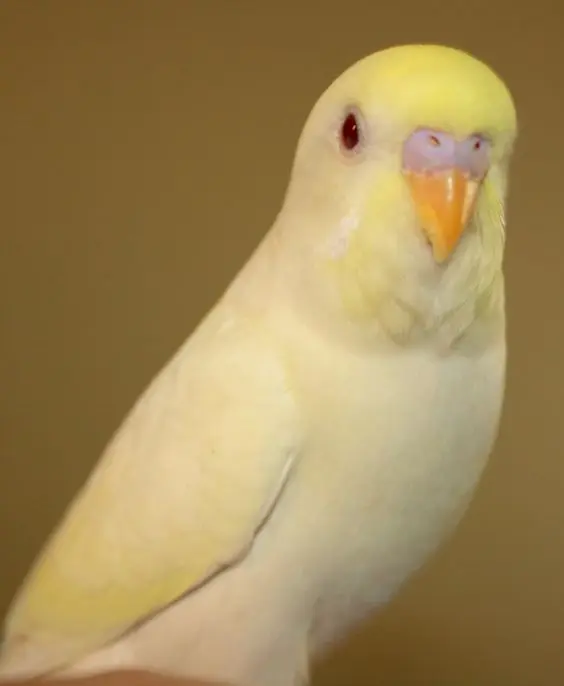
A sex-linked mutation refers to a gene mutation that is transferred to future generations on the X or Y chromosomes.
Anthracite budgie mutation is considered one of the rarest budgie mutations so far. Besides, slate and blackface budgie mutations are as rare as anthracite mutations.
Resources:
![What is a fallow budgie? [ALL MUTATIONS & VARIETIES]](https://www.petiska.com/wp-content/uploads/2022/03/what-is-a-fallow-budgie-all-mutations-varieties-1647686348-400x300.jpg)
![2023 Budgie Prices & Annual Cost Of A Budgie Calculation [UPDATED]](https://www.petiska.com/wp-content/uploads/2022/07/2023-budgie-prices-annual-cost-of-a-budgie-calculation-updated-1687207677-400x300.jpg)
